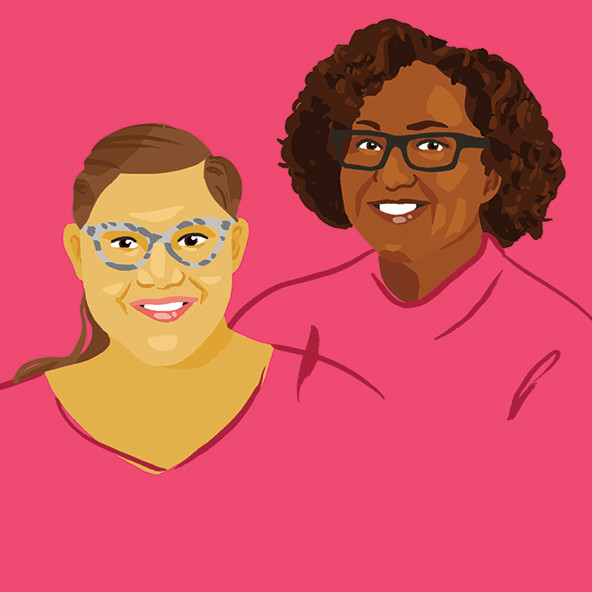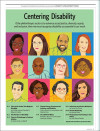 Daphne Frias and Valerie Novack (Illustration by Shannon May)
Daphne Frias and Valerie Novack (Illustration by Shannon May)
More than one billion people, or 15 percent of the global population, live with a disability, according to the World Health Organization. People with disabilities face significantly higher risks associated with the effects of climate change and environmental degradation but are often left behind in activism efforts. To effectively work toward climate and environmental justice, disability inclusion is essential.
Centering Disability

If the philanthropic sector is to advance social justice, diversity, equity, and inclusion, then it must recognize disability as essential to its work. This supplement offers critical perspectives and recommendations for dismantling ableism. Sponsored by the Disability & Philanthropy Forum
Achieving meaningful change requires a holistic view of our communities. Because sustainability, justice, equity, and resilience are interconnected, we cannot avoid talking about disability. Including people with disabilities in climate and environmental justice work, and following their lead will help us think beyond typical practices and assumptions and will empower us to address harms that we have yet to mitigate.
What role can philanthropy play in this vital work? The Disability & Philanthropy Forum invited Daphne Frias, a disabled youth activist working at the intersection of disability justice and the climate crisis, and Valerie Novack, a disabled disability-policy researcher who focuses on urban planning and emergency management, to a much-needed conversation about climate change, disability, and how philanthropy can take action.
Climate Justice
Valerie Novack: Many of the systems that contribute to or exacerbate climate change have similar effects on disability. The same economic systems that exploit and undervalue the Earth’s resources also exploit and undervalue people with disabilities and the places they live. In what ways do you see climate change as a disability rights and disability justice issue?
Daphne Frias: There is no justice without disability justice. Disabled people live at the intersection of all systems of oppression and social justice issues. There isn’t one issue or one intersection where you will not find disabled individuals experiencing the effects of social injustice or advocating for change. Disability justice and the climate crisis are connected because people with disabilities are some of the most vulnerable members of society and often the most impacted. The climate crisis can seem like a somewhat invisible issue, and disabled people can also feel invisible. We’re tackling two issues in trying to get people to notice and believe both the climate crisis and the need for disability justice.
Environmental Racism
Novack: It is essential to talk about environmental racism, both local and global, given the enormous disparities in access to resources as climate migration increases and certain regions of the world become less livable. Where we live can determine the types of crisis events associated with climate change and the practices that govern our responses, from segregated and under-resourced neighborhoods to heat islands caused by a lack of pervious surfaces. Disability can often be clustered in these areas (often because of the number of people with disabilities who are low income and people of color) and can also be created in these areas, due to factors such as pollutants in the air or water, lack of services, and insufficient shelter. So, environmental racism, poverty, and disability are often cyclical. How do you see environmental racism impacting those of us with disabilities?
Frias: This is a very personal topic for me. Born and raised in West Harlem, I didn’t realize that I was experiencing environmental racism until I went off to high school and college at predominantly white institutions. I realized that the neighborhoods I was going to for schooling looked radically different than the one I lived in.
To set the context, I lived near a bus depot for the Metropolitan Transportation Authority, one of the largest bus depots in New York City’s Manhattan borough. All buses for our borough came in and out of that bus station. We also had a water treatment plant that filters about 75 percent of water for the borough. We had an on-ramp to the West Side Highway, one of the city’s major highway systems. All this climate-destroying infrastructure was so abundant in my neighborhood. Looking at who lives there, it’s predominantly Black and brown individuals, immigrants, and people with low socioeconomic status. I have to wonder, why? What is the explanation?
The reason is environmental racism: the urban planning policies decided on by officials, and in prioritizing the health of the environment, how they have decided that some communities and individuals are disposable. It is imperative that we discuss the climate crisis as a social determinant of health. If we ask ourselves why Black and brown communities have higher rates of asthma, we also must look at where they live. These patterns have clear root causes. If we want to end this crisis, we cannot keep ignoring those who suffer disproportionately just because it makes us uncomfortable.
Natural Disasters
Frias: While we might have some warning, there’s still so much that is unpredictable about natural disasters. They often require rapid evacuations, which can pose challenges for disabled individuals who live in less-than-accessible environments. Can you speak about why people with disabilities are more at risk during a natural disaster?
Novack: There are multiple layers to why people with disabilities are at increased risk during a disaster, including their location and the number of people with disabilities who live in poverty and/or do not have immediate access to financial support, health care, or other resources. It is possible to reduce much of the risk with changes to crisis response and what factors are prioritized in preparedness planning.
Currently, emergency management practices are not very inclusive. I am disturbed by the lack of detailed guidelines for planning and emergency management that prioritize or center disability, despite consistently high death rates in this population during natural and other disasters. Climate change impacts people with disabilities by making certain regions, where there may be increased flooding, rising temperatures, or a lack of drinkable water, even less livable. When we aren’t included before disaster strikes, how will we be effectively accommodated during a crisis? When disability is an afterthought, or something squeezed into an existing response plan, risk is created that could have been planned for and perhaps avoided.
Ableism and Environmental Policies
Frias: We are often not included in conversations about climate and environmental justice, which are typically led by nondisabled individuals who create systems that are inaccessible. They have no social or spatial awareness of what it’s like to live with a disability, which I think is very problematic. They end up creating something that complies with federal policy but they’re not creating it for a livable experience, and that doesn’t work. As a disability policy researcher, how does policymaking perpetuate ableist systems?
Novack: Ableism has been built into our systems and practices. Without building together with people with disabilities and with individuals actively engaged in increasing real equity and inclusion, many solutions will uphold exclusion and ableism.
Regarding climate change, prioritizing personal ownership of environmental impacts over corporate environmental responsibility fuels ableism and discrimination toward people with disabilities (e.g., by focusing on reducing individual carbon footprints and maligning those who need single-use equipment). Similarly, policies with racist or ableist foundations allow narrow and sometimes inaccurate measures to be embedded in policy such as what was seen in some states allocation guidelines as ICU beds filled up due to COVID-19 cases using quality of life measures. Policies that reward individualism—home ownership, car ownership, productivity, and other “norms”—are likely to contribute to the same devaluation and erasure that characterize current policy, without addressing gaps in that policy area for people with disabilities and others who do not have access to the resources assumed in the policy.
Philanthropy and Disability Inclusion
Novack: Justice work requires considering the wholeness of people as well as the systemic issues they face. Bringing together climate and disability justice gets us closer to sustainable movements that protect all people. Disability movements have unique insights into access, flexible use, and interdependence that can benefit climate justice movements. Since disability is cross-identity, justice work that focuses on race, class, and place may allow for funding in various categories, with the same end goals. What do you want philanthropy to know about disability inclusion?
Frias: My message to philanthropy would be to listen to frontline communities. We have been experiencing the climate crisis before it was a popular topic of conversation. We are going to be the first individuals impacted by the climate crisis.
- Provide a seat at the table. It is really important when you enter boardrooms and executive conversations that you ask, “Does the room I’m stepping into reflect what the world looks like?” If it does not, I think that is a red flag. You cannot fight for social justice, and you cannot fight for the climate if the rooms where these conversations are happening do not look like the communities that are the most impacted. I don’t understand the concept of talking about communities without their presence. At the end of the day, the people who know those lived experiences best are the people who are living them.
- Listen to individuals with lived experience. The way social justice has looked isn’t the way social justice will continue to look. Even over the course of the pandemic, we’ve seen how organizing has changed from in-person conversations to virtual conversations, and many of us are going to move further into that virtual space. There’s no excuse not to have disabled people actively involved in these conversations. If there used to be barriers due to travel or health reasons, now we have largely embraced the power of the internet. The work must reflect the diversity and the richness of lived experiences.
- Work with disability leaders to find solutions. Instead of coming to us with full-fledged proposals and project initiatives, let us tell you what we need. We have solutions; we just don’t have the money. Let’s work together to make the end of the climate crisis a reality.
Disabled folks live with the anticipation of unknown challenges and difficulties around the corner, and with that prescience comes the ability to find silver linings and joy in the work. It’s exciting to find innovative solutions to the climate crisis because it means we have agency, we’re taking the problem into our own hands, and doing something about it.
Support SSIR’s coverage of cross-sector solutions to global challenges.
Help us further the reach of innovative ideas. Donate today.
Read more stories by Valerie Novack & Daphne Frias.

